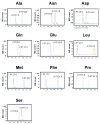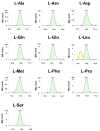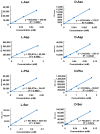Simultaneous Measurement of Amino Acid Enantiomers in Aged Mouse Brain Samples by LC/MS/MS Combined with Derivatization Using N α-(5-Fluoro-2,4-dinitrophenyl)-l-leucinamide (l-FDLA)
- PMID: 33467775
- PMCID: PMC7829926
- DOI: 10.3390/metabo11010057
Simultaneous Measurement of Amino Acid Enantiomers in Aged Mouse Brain Samples by LC/MS/MS Combined with Derivatization Using N α-(5-Fluoro-2,4-dinitrophenyl)-l-leucinamide (l-FDLA)
Abstract
D-amino acids have distinct roles from their l-enantiomer. In particular, some D-amino acids function as agonists or antagonists of neuronal receptors and are involved in higher brain functions. Thus, it is important to precisely measure the levels of these amino acid enantiomers in cells and tissues. Various quantification methods have been developed for measurements of chiral amino acids. However, each method has advantages and disadvantages. Additionally, measuring the amino acid enantiomers in crude biological samples requires a higher selectivity. In this study, we developed a quantification method for amino acid enantiomers using derivatization with N α-(5-Fluoro-2,4-dinitrophenyl)-l-leucinamide (l-FDLA) followed by liquid chromatography-tandem mass spectrometry (LC/MS/MS) with a conventional reversed-phase column. We simultaneously identified 10 chiral amino acids. Furthermore, we applied this method to investigate murine tissue samples and examined the effect of aging on the amino acid levels in aged brain regions. We found that aging decreased the levels of both D-serine and D-aspartate in the hippocampus. In addition, D-Phenylalanine in the thalamus significantly increased with age. In conclusion, our method is suitable for the quantification of the D-amino acids in crude biological samples and may contribute to elucidating the biological roles of chiral amino acids.
Keywords: D-amino acid; LC/MS/MS; aging; brain; l-FDLA.
Conflict of interest statement
The authors declare no conflict of interests.
Figures





Similar articles
-
Simultaneous measurement of amino acid enantiomers in the serum of late-life depression patients using convenient LC-MS/MS method with Nα-(5-fluoro-2,4-dinitrophenyl)-l-leucinamide Derivatization.J Pharm Biomed Anal. 2023 Jun 15;230:115387. doi: 10.1016/j.jpba.2023.115387. Epub 2023 Apr 5. J Pharm Biomed Anal. 2023. PMID: 37030045
-
Liquid chromatography-electrospray ionization-tandem mass spectrometric assay for d-aspartate N-methyltransferase activity in ark shells.Biosci Biotechnol Biochem. 2020 Mar;84(3):500-506. doi: 10.1080/09168451.2019.1689094. Epub 2019 Nov 6. Biosci Biotechnol Biochem. 2020. PMID: 31694479
-
Simultaneous enantiomeric determination of MDMA and its phase I and phase II metabolites in urine by liquid chromatography-tandem mass spectrometry with chiral derivatization.Anal Bioanal Chem. 2012 Nov;404(8):2427-35. doi: 10.1007/s00216-012-6385-9. Epub 2012 Sep 26. Anal Bioanal Chem. 2012. PMID: 23010844
-
Two-dimensional LC-MS/MS and three-dimensional LC analysis of chiral amino acids and related compounds in real-world matrices.J Pharm Biomed Anal. 2023 Oct 25;235:115627. doi: 10.1016/j.jpba.2023.115627. Epub 2023 Aug 8. J Pharm Biomed Anal. 2023. PMID: 37633168 Review.
-
Amino Acid Chirality: Stereospecific Conversion and Physiological Implications.ACS Omega. 2024 Jan 26;9(5):5084-5099. doi: 10.1021/acsomega.3c08305. eCollection 2024 Feb 6. ACS Omega. 2024. PMID: 38343938 Free PMC article. Review.
Cited by
-
Indirect Enantioseparations: Recent Advances in Chiral Metabolomics for Biomedical Research.Int J Mol Sci. 2022 Jul 4;23(13):7428. doi: 10.3390/ijms23137428. Int J Mol Sci. 2022. PMID: 35806433 Free PMC article. Review.
-
Metabolomic insights into late-life depression: a systematic review.BMC Geriatr. 2025 Aug 13;25(1):618. doi: 10.1186/s12877-025-06256-2. BMC Geriatr. 2025. PMID: 40804658 Free PMC article.
-
Untargeted Metabolomics Insights into Newborns with Congenital Zika Infection.Pathogens. 2021 Apr 13;10(4):468. doi: 10.3390/pathogens10040468. Pathogens. 2021. PMID: 33924291 Free PMC article.
-
Oral Administration of Nicotinamide Mononucleotide Is Safe and Efficiently Increases Blood Nicotinamide Adenine Dinucleotide Levels in Healthy Subjects.Front Nutr. 2022 Apr 11;9:868640. doi: 10.3389/fnut.2022.868640. eCollection 2022. Front Nutr. 2022. PMID: 35479740 Free PMC article.
-
Arrow of Time, Entropy, and Protein Folding: Holistic View on Biochirality.Int J Mol Sci. 2022 Mar 28;23(7):3687. doi: 10.3390/ijms23073687. Int J Mol Sci. 2022. PMID: 35409047 Free PMC article. Review.
References
-
- Usiello A., Di Fiore M.M., De Rosa A., Falvo S., Errico F., Santillo A., Nuzzo T., Chieffi Baccari G. New Evidence on the Role of d-Aspartate Metabolism in Regulating Brain and Endocrine System Physiology: From Preclinical Observations to Clinical Applications. Int. J. Mol. Sci. 2020;21:8718. doi: 10.3390/ijms21228718. - DOI - PMC - PubMed
Grants and funding
LinkOut - more resources
Full Text Sources
Other Literature Sources

